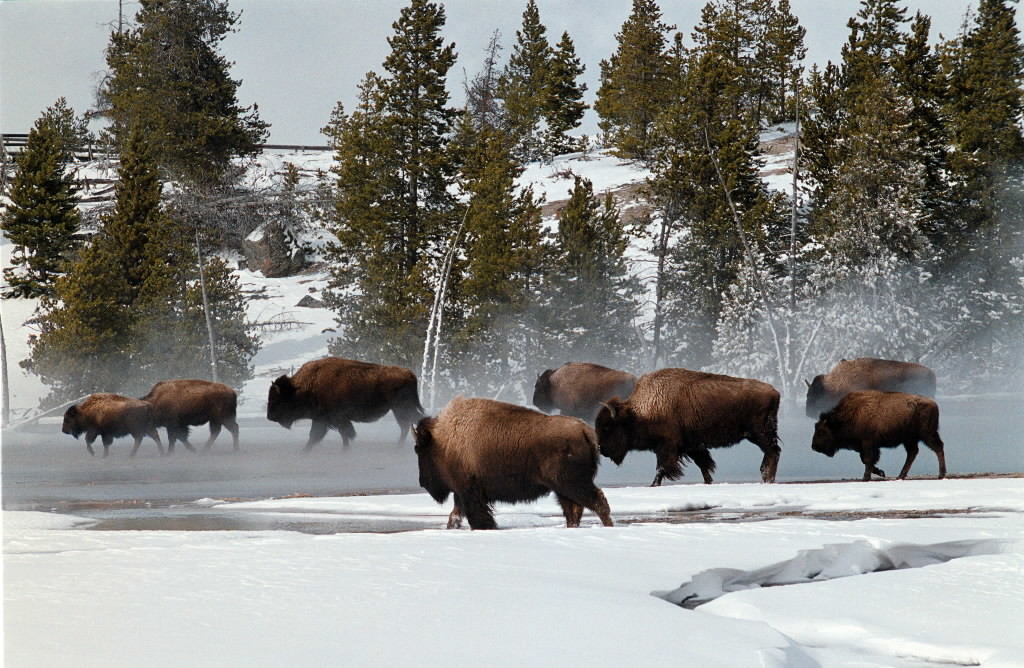Emotions are running high in Montana as the government contemplates proposals to restore bison herds to various parts of the state. More than 600 people attended eight Montana Fish, Wildlife, and Parks (FWP) field hearings in May on restoring bison while a state judge blocked an FWP plan to restore bison to the Fort Belknap Indian Reservation.
Judge Blocks Reintroduction
A Montana district court on May 9 blocked a state plan to relocate several dozen bison from the Fort Peck Reservation to the Fort Belknap Indian Reservation in north central Montana. The Fort Peck bison arrived from Yellowstone National Park in March after getting a clean bill of health after a quarantine period outside the park.
Area ranchers fear the reintroduction of bison will jeopardize livestock. Bison compete with cattle for grazing grounds and are prone to carrying brucellosis, which can transfer to cattle and cause spontaneous abortions of cattle fetuses. Ranchers also fear free-roaming bison will damage fences and other private property.
The Montana district court ruled the Fort Peck bison must remain where they are until plaintiffs receive a verdict on the merits of their lawsuit to stop reintroduction of bison to areas outside the Fort Peck Reservation. The court ruled the potential injury to ranchers outweighed the potential injury to state wildlife managers and bison recipients if the bison were reintroduced outside the reservation while the lawsuit was still pending.
State Conducts Field Hearings
Meanwhile, Montana Fish, Wildlife, and Parks heard from concerned citizens in field hearings throughout the state. FWP officials allowed citizens to express their support or opposition to bison reintroduction and diligently took notes about the reasons given. A majority of the comments opposed widespread reintroduction of bison.
FWP hopes to issue a draft environmental impact statement (EIS) by early 2013. The draft would be followed by public hearings and a final EIS roughly one year later.
Threat to Cattle
Carl Graham, president of the Montana Policy Institute, says the Yellowstone National Park free-range bison herd is especially significant because it has no cattle blood, making it probably the only one in the world with this distinction.
However, he added, “Periodically, they go out of the park and onto private land. They carry brucellosis, which is especially harmful to cattle, and can lead to infection, quarantine, and slaughter of the entire herd. So the challenge is: What do you do with the bison that wander away from their herd?” asks Graham.
One method of controlling the strays is “hazing,” which involves chasing the wayward bison by helicopters or on horseback and driving them back to Yellowstone. Despite its effectiveness, hazing is frowned upon by environmentalists, who view it as harassment of the animals.
Seeking a Solution
Ted Turner, founder of CNN, volunteered to take 40 of the strays and keep them for two or three years until they could be tested and proven brucellosis-free, so they could then be released as part of a proposed free-range herd to be established in the state.
So far, Montana has not come up with an acceptable plan to deal with the wandering bison, says Graham, so the issue remains very contentious between ranchers and conservationists, including many national organizations that otherwise have no stake in Montana-specific issues.
Reintroducing free-roaming bison “all sounds wonderful unless you’re living off the land,” said Graham. “People outside of Montana need to realize there are people here working the land and supporting their families.”
“This all comes down to the fact that bison don’t care about fences,” Graham explained.
‘Large Environmental Footprint’
Ariel Overstreet, communications director for the Montana Stockgrowers Association, a state organization representing Montana’s cattle ranching families, agrees.
“The ranchers are concerned because the bison go where they want to go. They’re pretty big animals and have a large environmental footprint. One rancher lost $20,000 worth of hay when a small group came onto his land. Mostly they damage fences, but the biggest concern is that diseased bison will mix with local cattle and get them sick and the whole herd would be lost,” Overstreet said.
“Although the Tribes and environmentalists say they want the bison, the majority of Montanans are against it,” she observed. “This [push for reintroduction] appears to be happening because of [people outside the state]. It’s very similar to when they reintroduced wolves here. There were lots of losses of livestock by cattlemen, and we anticipate that reintroducing the bison will cause a similar result.”
“In the end, we have to ask: Who’s going to pay for it?—because bison do a lot of damage,” said Overstreet.
Kenneth Artz ([email protected]) writes from Dallas, Texas.





